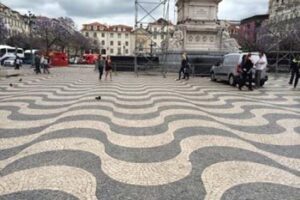
La Garrotxa Volcanic Zone Natural Park, Catalonia’s Volcano Country
By R. Daniel Foster
Catalonia, situated on the Iberian Peninsula in northeast Spain, offers a traveler’s playground of coastal inlet towns and rugged trails that weave through the Pyrenees.
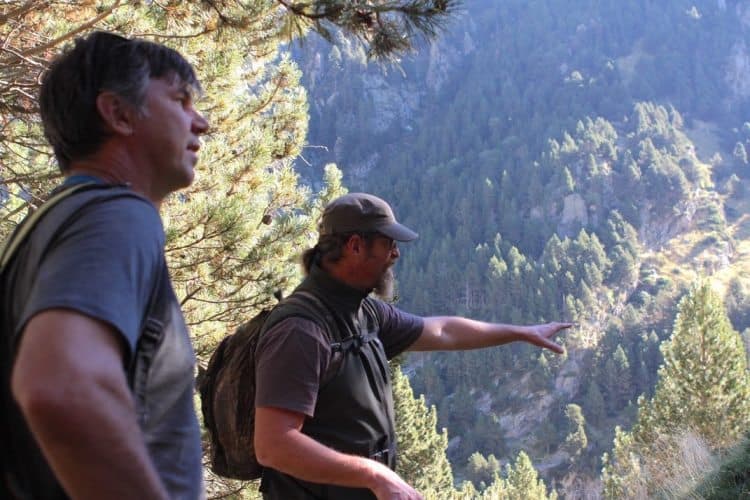
Catalonia simply feels authentic, with holdovers from rule by the Crown of Aragon. Medieval remnants include towns yet rich in Gothic architecture (Peratallada and Besalú among others), the rugged yet serene Costa Brava region, Romanesque churches, monasteries, and hiking and bicycling routes favored by Europeans during their own vacations.
All that is washed down by ratafia, a local digestive liquor famous for its robust blend of anise, rosemary, lemon peel, nutmeg, cinnamon, clove, and mint. For Spaniards, more is always better.
The best of Catalonia (Catalunya in Catalan; Cataluña, Spanish) is a mere day trip away from the sophisticated yet accessible Barcelona. My recommendation: why hurry back? Spend a few nights.

La Garrotxa
Distance, drive time: 74 miles, 1.40 hours
By train, via Girona, including drive to Garrotxa, 1.50 hours
La Garrotxa Volcanic Zone Natural Park
Garrotxa is Catalonia’s volcano country. The county’s name literally means “rough, uneven land.” The terrain is strewn with lava fields from centuries of violent eruptions, now lushly carpeted.
Surrounding the capital city of Olot, 40 volcanic cones are protected within the 75-mile La Garrotxa Volcanic Zone Natural Park.
The park is spread over eleven municipalities and features 28 walking routes; all have excellent signage. Some of the routes join the Itinerànnia network of trails, which traverse the Pyrenees and lead to Costa Brava beaches.
Don’t worry. None of the 40 volcanoes within the park are active. The last eruption occurred about 11,500 years ago.
Climb a volcano
Park Highlights include the Santa Margarida Volcano (2,238 feet), which you can climb. The volcano has a wide circular crater –– at the center of which you’ll find a small Roman hermitage built of stone, looking rather lonely.

Placed center in the crater’s wide expanse, it’s the only building you will see. The door is locked, but you can peer inside, and during hot summer months, its walls provide needed shade after the hike.
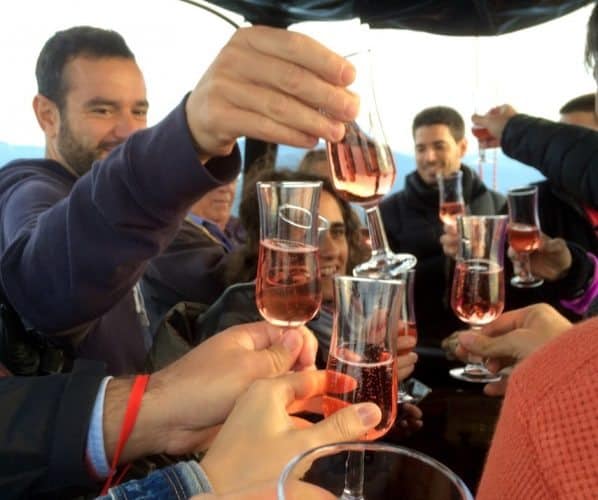
The Santa Margarida crater doesn’t seem standard for a volcano –– today the bowl is largely covered with pastureland.
But look around to the forest of oaks and evergreen that wreathe the center and you’ll notice the rising slope. An era or two earlier, you wouldn’t have wanted to stand in the spot.
The park’s website has maps, hiking routes, and more information on the volcanoes.
The area has ample parking, some of it free and some metered on the weekends.
Medieval towns within the Volcanic Park
The towns of Olot, Sant Joan les Fonts, Castellfollit de la Roca, and Santa Pau are all found within the park — entire medieval villages and Romanesque churches can be explored.
For more information, visit the park’s overview of Romanesque attractions.
Among numerous towns, two sure bets are Besalú and Santa Pau. Besalu is most recognized by its grand Romanesque bridge over the Fluvia river. Gently sloping streets, curious shops, and outdoor cafes make for an idyllic few hours of walking.
Monasteries and miniatures
Besalu’s Benedictine monastery, Sant Pere is worth a look. The building dates to 977 and was renovated in 1160, and has undergone plenty of maintenance since. Gaze up to the ambulatory’s decorated columns; the capitals feature some humans, and if you look close, you may spot a devil or two. Besalu is about 13 miles from the capital of Garrotxa, Olot. Plaça Prat de Sant Pere Besalu. +34 972 59 02 25.
Besalu’s Museum of Miniatures is noteworthy — if you’re into very small things. On display: 2000 pieces, some up to 500 times smaller than normal-sized models. Rooms containing micro miniatures are up to 100,000 times smaller than actual size. You may, in fact, need a microscope to view the creations. Plaça Prat de Sante Pere, 15, +34 972 59 1842.
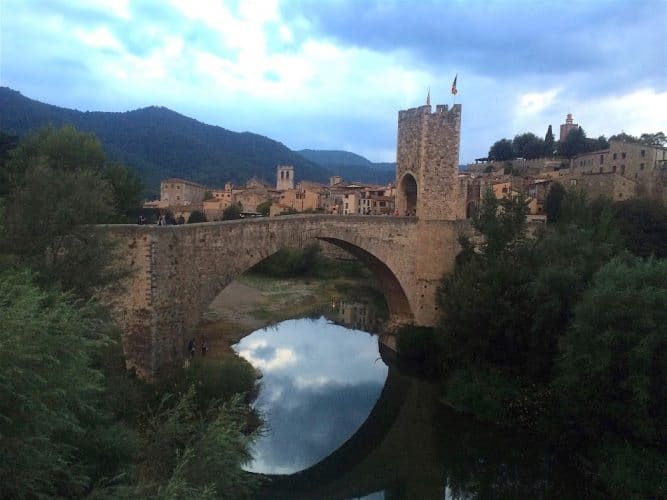
The city of volcanoes
The capital city of Olot is known as ‘the city of the volcanoes’ since there are four volcanoes right within the town’s boundaries.
Museums worth a look : Casa-Museu Can Trincheria, a noble house dating to the late 18th century; and Museu dels Volcans with its exhibits that fully familiarize one with volcanic science, including simulations of eruptions.
The long-celebrated Olot Festival (around September 8), is the city’s cultural standout. The event pays homage to the city’s patron saint, the Virgin of the Tura Shrine, who is also termed the Black Madonna of Olot –– she can be found in Olot’s Tura church.
The festival’s mainstay: colorful street parades with folkloric effigies, some of them enormous, towering over crowds packed in the city’s squares.
Hike, bike –– explore Garrotxa County
The overall county of Garrotxa is an ideal place to hike, bike or explore medieval towns. From the mountains to the coast, one can cycle or hike all the way from the Girona Pyrenees down to Costa Brava beaches.
Garrotxa travelers can reach nearly any pocket of the county via the trails, which are well marked. A route planner can help spark your adventure. Complete maps are also available.
Garrotxa Cultour app makes touring the region easy
The optimal way I discovered to obtain a regional snapshot (and then drill down to detail), was by downloading the free Garrotxa Cultour app for iPhone and Android. The app will allow you to navigate among 15 different county routes. You can search for detailed information about individual sites or towns, view photos and even play games to learn about the region. I was impressed.
Bicycling Garrotxa
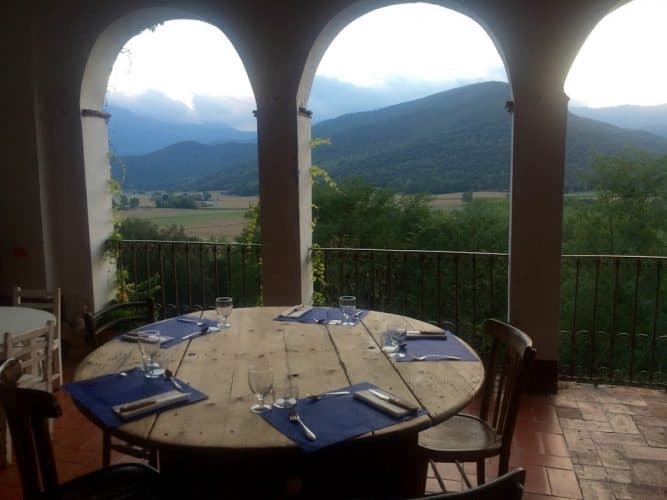
As a whole, the Girona province (Garrotxa is a county within Girona) offers superior routes for bicycling; pro cyclists from around the world favor the area.
The Carrilet cycle lane (also for walkers) follows the route of a railway that once linked Olot and Girona.
Travelers cycle or walk along narrow rail tracks for much of the route, which spans about 14 miles. You can hike some, or all of the path, which passes through volcanic formations and towns.
The low-gradient route (on average, about 1.5% grade) makes for even, pleasant traveling –– the entire 14-mile span is not out of reach if you begin the trek around dawn.
The route begins at the Fonts de Sant Roc springs and travels through the villages of the municipality of La Vall d’en Bas. Check out these suggested routes.
Garrotxa by air
Hot air ballooning is popular in Garrotxa (imagine looking down on all those volcanoes). Excursions are offered by Vol de Coloms , with trips launching from the La Garrotxa Volcanic Zone Natural Park.
The 1.5-hour journey soars across volcano cones and the La Fageda d’en Jordà beech forest. Flights for two people are offered (how romantic) as well as for families.
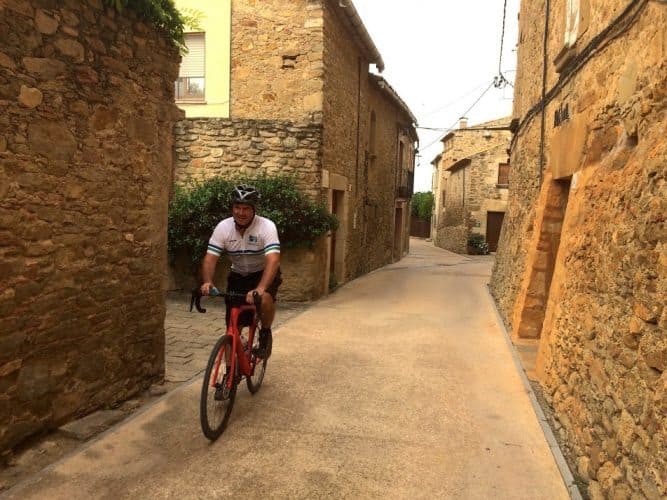
Champagne toasts, traditionally offered post-flight after landing, are served during the aerial adventure. Refills seemed endless. Spaniards seem to say: why wait?
Visit Spain’s main tourism site for travel assistance and itineraries throughout the country.
Visit the Costa Brava tourism site to explore journeys in the region, including the Pyrenees.

R. Daniel Foster is an award-winning filmmaker, documentarian, and writer whose articles and photographs are regularly published in the Los Angeles Times. He specializes in world culture and image. www.rdanielfoster.com
Eurail Passes: What to Know about Buying a Europe Train Pass
- Fall Clothing for Your Travels - August 30, 2024
- Mekong Chronicles: The River That Shaped Southeast Asia - August 28, 2024
- Gadgets and Goodies You Might Enjoy - August 27, 2024



